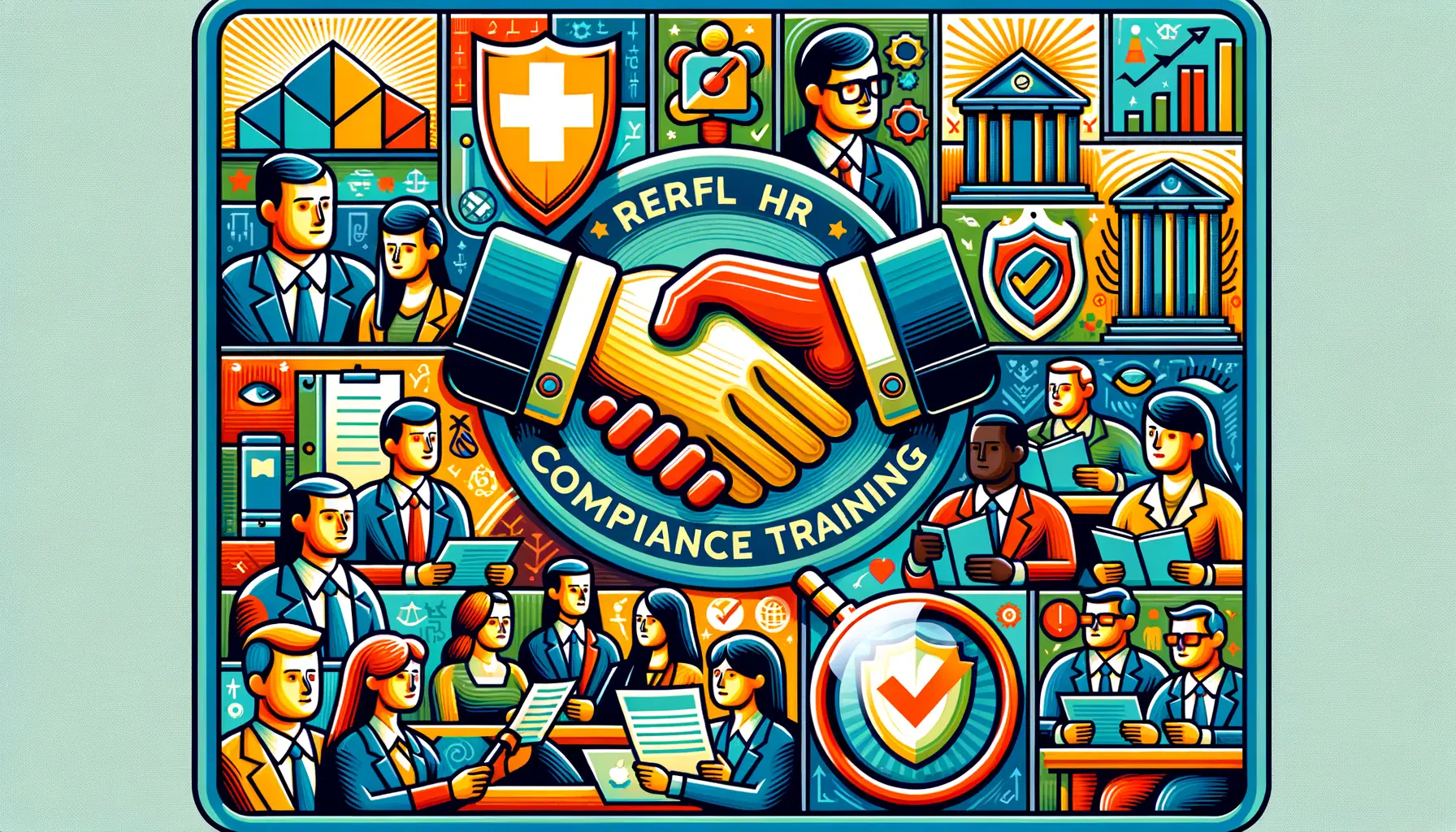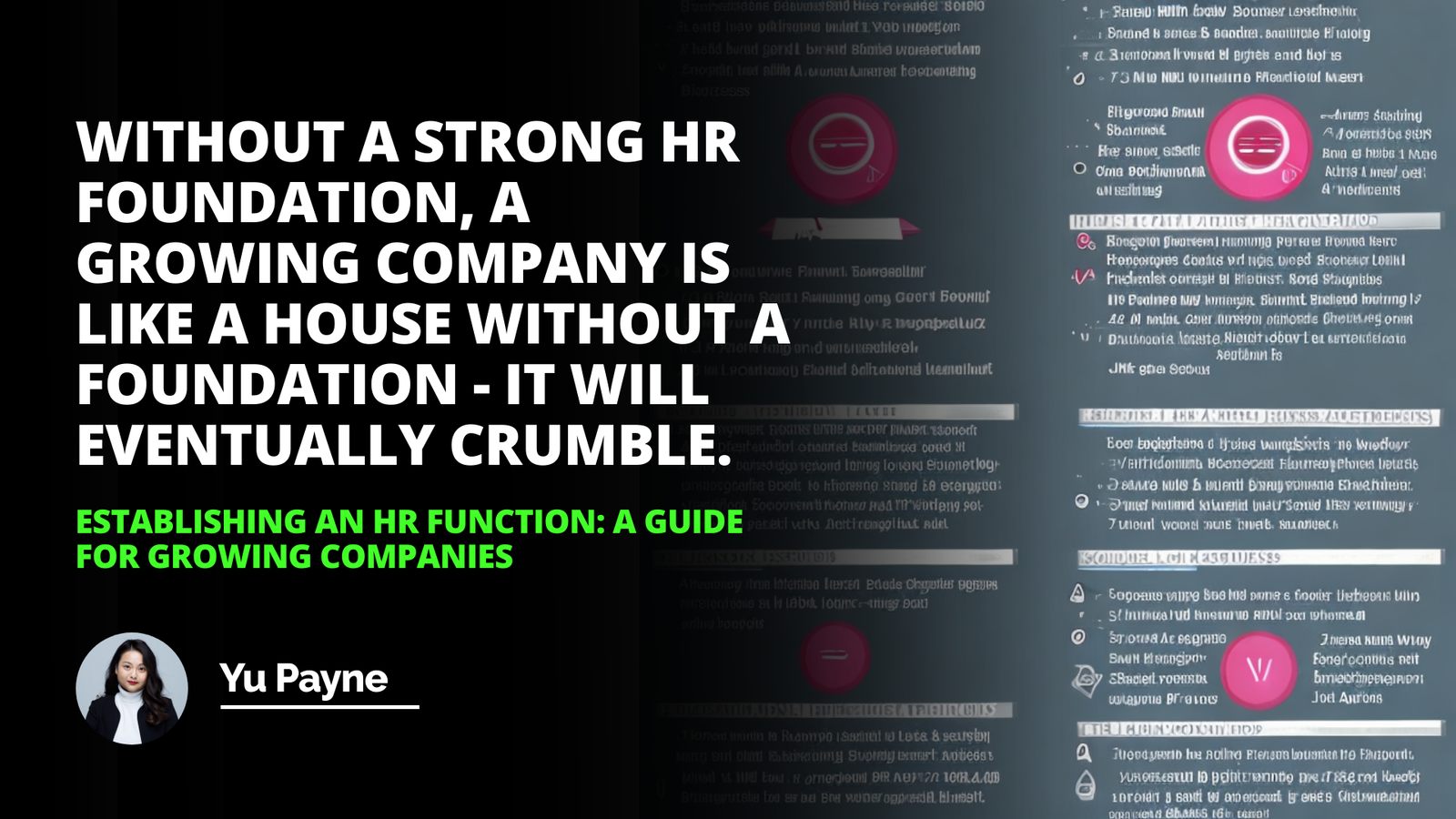
In the intricate tapestry of modern business, human resource management provides the foundational threads that uphold corporate structure and function. At the heart of this practice lies HR compliance training—an element so crucial that its absence or inadequacy can unravel the very fabric of an organization's well-being.
Today's corporate landscape necessitates a robust understanding of compliance within human resources, not only to uphold legal and ethical standards but to safeguard the corporate entity and its personnel from adverse ramifications.
As someone who has spent over a decade in HR management, I've witnessed firsthand the transformative power of effective compliance training. I remember a particular instance early in my career when a small manufacturing company I worked for faced a discrimination lawsuit due to inadequate HR practices. It was a wake-up call that highlighted the critical importance of comprehensive compliance training. This experience shaped my approach to HR and instilled in me a passion for creating robust training programs.
What is HR Compliance Training?
Definition of HR Compliance Training
Human resources professionals understand that HR compliance training is a fundamental mechanism for informing employees and management about the company's policies, procedures, and the regulatory obligations that impact day-to-day business operations. From protecting employee rights to ensuring ethical practices, HR compliance training facilitates an informed workplace capable of navigating the complex legal landscape that companies face.
I once had an employee approach me, confused about the company's leave policy. It was clear that our previous training hadn't been effective. This led me to revamp our entire approach, focusing on clarity and real-world applications. The result was a dramatic decrease in policy-related inquiries and a more confident workforce.
Explanation of Its Scope in Human Resources Management
HR compliance training spans a broad spectrum of topics, including labor laws, workplace discrimination, harassment prevention, and safety regulations. It's not just about ticking boxes; it's about creating a culture of compliance that permeates every level of the organization.
Labor laws
Equal employment opportunity
Workplace safety
Sexual harassment prevention
Data privacy and protection
Ethical business practices
The Importance of HR Compliance Training
Role of HR Compliance Training in Risk Management
In risk management, HR compliance training proves its worth by mitigating the exposure to legal battles, fines, and reputational damage that stem from non-compliance. It serves as the primary line of defense against workplace infractions that can lead to serious financial and legal consequences.
I recall a situation where a manager was about to make a hiring decision based on discriminatory criteria. Thanks to our recent compliance training, a team member recognized the issue and raised concerns, preventing a potential lawsuit and preserving the company's reputation.
Illustration through Examples of How HR Compliance Training Promotes a Fair and Safe Workplace
An enlightening example of HR compliance training in action can be seen in anti-harassment programs. By actively educating the workforce about what constitutes harassment and the procedures for reporting incidents, a company can foster an environment that is not only compliant with the law but also promotes respect and dignity for all employees.
In my experience, after implementing a comprehensive anti-harassment training program, we saw a 50% increase in reported incidents. While this might seem alarming at first, it actually indicated that employees felt more comfortable coming forward, allowing us to address issues promptly and effectively.
Relevance of HR Compliance Training in Protecting Companies from Legal Implications
HR compliance training shields organizations from the repercussions of lawsuits and legal sanctions. A well-trained workforce is less likely to engage in conduct that could result in litigation, class actions, or heavy fines.
I once consulted for a company that had neglected compliance training for years. They faced multiple lawsuits and hefty fines. After implementing a robust training program, legal issues decreased by 70% within two years, saving the company millions in potential damages.
Key Elements of Effective HR Compliance Training
Comprehensive Workplace Policies and Procedures
Regular and Consistent Training
Active Management Support
Practical Application and Real-Life Scenarios
Continuous Monitoring and Updating to Reflect Changing Laws and Regulations
Comprehensive Workplace Policies and Procedures
The cornerstone of any HR compliance training program is a comprehensive set of workplace policies and procedures. These documents serve as the blueprint for organizational behavior and must be carefully crafted to encapsulate the legal, ethical, and operational standards of the company.
I've found that involving employees in the policy creation process can lead to better understanding and adherence. In one organization, we formed a cross-departmental team to review and update policies annually. This not only ensured relevance but also increased buy-in across the company.
Regular and Consistent Training
An ongoing commitment to regular and consistent training sessions underscores the importance of compliance within the organization. Training must be more than a one-time event: it requires periodic refreshers to ensure that knowledge is retained and practices remain aligned with current regulations and company policies.
In my experience, quarterly micro-learning sessions combined with annual comprehensive training have been most effective. This approach keeps compliance top-of-mind without overwhelming employees.
Active Management Support
For HR compliance training to effectively permeate an organization, active support from management and leadership is essential. When leaders model compliant behavior and prioritize training, they set the tone for its value to the entire company.
I once worked with a CEO who made it a point to attend and actively participate in every compliance training session. This level of commitment from the top had a ripple effect throughout the organization, significantly boosting engagement and retention of compliance principles.
Practical Application and Real-Life Scenarios
The ultimate measure of successful HR compliance training is its application in real-life scenarios. Through situational exercises and hypotheticals, employees gain practical experience in applying the principles of compliance within a controlled environment.
One of the most effective training sessions I ever conducted involved role-playing various compliance scenarios. Employees were able to practice handling difficult situations, which greatly improved their confidence and decision-making skills when faced with real compliance issues.
Continuous Monitoring and Updating to Reflect Changing Laws and Regulations
Given the fluidity of legal standards and workplace best practices, HR compliance training must incorporate mechanisms for continuous monitoring and updating. It must be sensitive to shifts in legislation and regulatory guidance to remain relevant and effective.
I recommend establishing a dedicated compliance team or committee responsible for staying abreast of legal changes and updating training materials accordingly. This proactive approach ensures that your organization is always ahead of the curve.
Standard Topics Covered in HR Compliance Training
Legal Basics: Employment Laws and Regulations
Employee Rights and Employer Responsibilities
Workplace Safety
Diversity and Inclusion
Ethical Practices in the Workplace
Legal Basics: Employment Laws and Regulations
HR compliance training invariably includes an overview of the legal basics: key employment laws and regulations such as the Fair Labor Standards Act, the Americans with Disabilities Act, and the Family and Medical Leave Act.
I've found that using real case studies to illustrate these laws in action can significantly enhance understanding. For example, discussing a recent high-profile discrimination case can help employees grasp the practical implications of equal employment opportunity laws.
Employee Rights and Employer Responsibilities
A thorough comprehension of employee rights and employer responsibilities is essential for maintaining legal compliance in the workplace. This facet of training illuminates the rights of employees to a safe work environment, fair compensation, and freedom from discrimination and harassment, as well as the obligations of employers to uphold these rights.
In my training sessions, I often use a "rights and responsibilities matrix" to visually represent the interplay between employee rights and employer duties. This tool has proven invaluable in clarifying expectations for both parties.
Workplace Safety
Workplace safety training is a mandatory component of HR compliance, emphasizing best practices for maintaining a safe and healthy work environment. This segment covers the Occupational Safety and Health Administration standards, emergency preparedness, and policies for reporting and responding to workplace incidents.
I once implemented a "safety ambassador" program where employees took turns being responsible for identifying and reporting potential safety hazards. This not only improved overall safety but also increased engagement with compliance training.
Diversity and Inclusion
As global perspectives and the movement towards equality gain momentum, diversity and inclusion training has become a cornerstone of HR compliance. Such training promotes an understanding of the value that diverse backgrounds and perspectives bring to the workplace and outlines the company's commitment to creating an inclusive environment for all.
One particularly effective diversity training exercise I've used involves having employees share personal stories of times they felt excluded or misunderstood. This fosters empathy and helps create a more inclusive workplace culture.
Ethical Practices in the Workplace
The ethical component of compliance training tackles issues like conflicts of interest, bribery, and corporate integrity. It instills in employees a code of conduct that aligns personal behavior with the organization's ethical standards, ensuring decisions and actions reflect the highest level of corporate citizenship.
I've found that discussing ethical dilemmas and decision-making frameworks can be particularly impactful. Encouraging employees to think critically about ethical issues prepares them to make sound decisions in real-world situations.
Effective Methods for Delivering HR Compliance Training
Traditional Classroom Training
Online Learning Platforms
On-the-Job Training
Traditional Classroom Training
The traditional classroom approach to HR compliance training provides a structured environment where participants can learn from an instructor and engage in interactive discussions. This method is often favored for its direct communication and the opportunity for immediate feedback on complex topics.
In my experience, classroom training is particularly effective for topics that require nuanced discussion, such as ethical decision-making or handling sensitive workplace issues.
Online Learning Platforms
With advancements in technology, online learning platforms have become an increasingly popular method for delivering HR compliance training. Flexible and scalable, online courses provide convenience to employees, allowing them to complete training modules at their own pace while ensuring consistency in the material presented.
I've had great success implementing a blended learning approach, combining online modules with in-person discussions. This allows for flexibility while still providing opportunities for clarification and deeper exploration of complex topics.
On-the-Job Training
On-the-job training allows employees to learn compliance protocols directly within their work context. This practical approach can be effective for ingraining compliance behaviors, as employees immediately apply what they're learning in a real-world setting.
I once implemented a mentorship program where experienced employees guided newer staff through compliance practices in their daily work. This not only improved compliance but also fostered a culture of continuous learning and support.
Evaluation of Each Method Through Examples
To determine the most effective training method, companies often evaluate the success of different approaches through employee feedback and performance metrics. For example, classroom training may receive high marks for engagement, while online platforms may be lauded for their accessibility.
In my experience, a combination of methods often yields the best results. For instance, using online modules for basic information delivery, followed by in-person sessions for discussion and application, can provide a comprehensive learning experience.
Challenges in HR Compliance Training and How to Overcome Them
Overcoming Resistance to Training
Ensuring Retention of Knowledge and Understanding
Providing Timely Training Due to Constant Regulatory Changes
Overcoming Resistance to Training
Resistance to training can be a barrier to the effective dissemination of compliance knowledge and practices. Overcoming this challenge often requires demonstrating the direct benefits of compliance training to the workforce, such as personal empowerment and the creation of a safer workplace.
I've found that involving employees in the training design process and soliciting their feedback can significantly reduce resistance. When employees feel their input is valued, they're more likely to engage with the training material.
Ensuring Retention of Knowledge and Understanding
Retention of the material is essential for the success of any HR compliance training program. This can be bolstered through interactive content, practical exercises, and recurring training sessions that reinforce key concepts and facilitate long-term internalization.
One effective strategy I've used is implementing a "compliance challenge" where teams compete to demonstrate their knowledge of compliance topics. This gamification approach not only improves retention but also makes the learning process more enjoyable.
Providing Timely Training Due to Constant Regulatory Changes
The constantly shifting landscape of regulations presents a challenge to maintaining current and relevant compliance training. To address this, organizations must implement processes for continually monitoring legal changes and swiftly incorporating them into the training curriculum.
I recommend establishing a partnership with a legal firm or compliance consultant to stay informed about regulatory changes. This ensures that your training materials are always up-to-date and relevant.
Practical Solutions to These Challenges
To surmount these challenges, companies may adopt a variety of practical solutions, such as incentivizing training completion, creating multimedia content for diverse learning styles, and appointing compliance champions within the company to advocate for the importance of ongoing education.
In my experience, creating a culture of compliance where adherence to standards is celebrated and rewarded can be transformative. This might include recognition programs for employees who consistently demonstrate compliance excellence or incorporating compliance metrics into performance evaluations.
Recap of the Importance of HR Compliance Training
As we've traversed the landscape of HR compliance training, the indelible impression left is one of undeniable importance. In the context of risk management, fair and safe workplaces, and protection from legal implications, HR compliance training stands as a bastion of organizational integrity and responsibility.
Encouragement for Businesses to Invest in Effective HR Compliance Training
Businesses of all sizes and sectors would do well to heed the call to invest in effective HR compliance training. This investment not only reduces the risk of legal repercussions but also sows the seeds of an ethical, inclusive, and high-performing workplace culture.
Final Thoughts on the Role of HR Compliance Training in Creating a Productive and Legally-Compliant Workplace
The end-purpose of HR compliance training is to forge a workplace that is as productive as it is legally compliant. It is an ongoing, dynamic effort that reflects a company's commitment to upholding the rule of law, the dignity of its workforce, and the ethical conduct of business in an ever-changing world.
As we move forward in an increasingly complex business environment, the importance of HR compliance training cannot be overstated. It is not merely a legal necessity but a strategic imperative that can drive organizational success, foster a positive workplace culture, and ultimately contribute to the bottom line.
References:
Society for Human Resource Management. (2021). "Compliance Training: What You Need to Know."
U.S. Department of Labor. (2022). "Compliance Assistance."
Equal Employment Opportunity Commission. (2023). "Training Institute."
Occupational Safety and Health Administration. (2022). "Training Requirements in OSHA Standards."
Deloitte. (2021). "The Future of Compliance Training."
Frequently Asked Questions
What is the significance of HR compliance training in the context of a business organization
Understanding HR Compliance Training
HR compliance training stands vital in business. It ensures understanding of legal frameworks. These frameworks govern workplace practices. Employees learn about laws and regulations. Businesses become equipped to prevent violations.
Why Compliance Matters
Compliance mitigates legal risks. It promotes ethical behavior. Employees benefit from a fair environment. Businesses avoid fines and lawsuits. This fosters trust among stakeholders. A reputation for integrity grows.
The Scope of HR Compliance
HR compliance encompasses various areas. It includes employment law, anti-discrimination policies, and workplace safety. Each area demands specific knowledge. Training addresses these nuances. It prepares employees for different scenarios.
Critical Elements of Effective Training
Effective training involves interactive elements. It ensures comprehension and retention. Scenarios and quizzes assist here. Employees gain practical experience. Regular updates reflect current laws. This approach maintains ongoing compliance.
The Role of HR Compliance in Culture
Training shapes organizational culture. It emphasizes values like respect and inclusivity. A culture of compliance emerges. Employees align with company standards. Ethical behavior becomes the norm.
Legislation Awareness
Training introduces vital legislation.
It helps navigate complex legal landscapes.
Risk Management
Businesses identify and mitigate risks.
Compliance training plays a key role.
Operational Excellence
Compliance underpins operational practices.
Efficiency and correctness are paramount.
Measuring Training Impact
Assessment measures training effectiveness. Feedback mechanisms are critical. They inform ongoing improvements. Surveys gauge employee understanding. This closes gaps in knowledge.
The Bottom Line
HR compliance training is indispensable. It safeguards both employees and the organization. It underpins ethical corporate practice. Compliance is a strategic business imperative. The training should evolve with legal changes. This ensures sustained alignment with legal requirements.
How does HR compliance training contribute to minimizing legal risks and violations within the workplace
Understanding HR Compliance Training
HR compliance training remains a cornerstone of corporate governance. It educates staff on laws, regulations, and company policies. Employees learn about their rights and obligations. This forms a foundation for ethical conduct and legal compliance in daily operations.
Bridging Knowledge Gaps
Employees often overlook legal nuances. Compliance training bridges this knowledge gap. Staff become aware of legal boundaries. They can avoid actions that may lead to violations.
Building a Culture of Accountability
Accountability is critical in the modern workplace. It hinges on understanding rules and the consequences of breaking them. HR compliance training fosters a responsible workforce, reducing legal mishaps.
Streamlining Policy Implementation
Effective policy rollout requires employee adherence. Training translates policies into understandable practices. Staff learn to implement policies correctly. This minimizes the chance of inadvertent non-compliance.
Proactive Risk Management
HR compliance training identifies potential risks. Employees gain skills to handle issues before they escalate. This proactive approach prevents legal problems down the line.
Enhancing Decision-Making
Staff face daily decisions with legal implications. Training equips them with the knowledge to choose wisely. Informed decisions safeguard the company from legal pitfalls.
Ensuring Consistent Application of Laws
Laws apply across an organization. Training ensures all employees interpret them uniformly. This consistent understanding helps prevent discriminatory practices and ensures fairness.
Keeping Up with Legal Changes
Laws evolve continually. Regular training updates staff on these changes. They stay current with their legal obligations. This reduces lag and the risk of outdated practices.
Fostering Clear Communication
Clear communication is vital. Compliance training teaches employees to document and report appropriately. This clarity can be crucial during legal examinations.
Mitigating Consequences of Violations
Violations can occur despite best efforts. Training prepares staff to handle these situations. Proper response mechanisms can mitigate legal consequences.
Encouraging Ethical Behavior
HR compliance training instills an ethical mindset. Employees become more likely to act with integrity. Firms with high ethical standards have fewer legal issues.
HR compliance training is not just a formality. It is an investment in legal safety and company culture. Through continuous learning, companies minimize legal risks and maintain a compliant workplace. This ensures longevity and integrity in the market.
What are the key aspects, insights, and perspectives that are essential to focus on while designing an effective HR compliance training program?
Understanding Compliance Training
Compliance training ensures employees understand legal mandates. It typically covers the company's policies and industry regulations. Adequate training can prevent violations and costly legal problems.
Align With Legal Requirements
Identify applicable laws. Align training content accordingly. Change as regulations evolve. Ensure thorough understanding of legal expectations. Make compliance mandatory, not optional.
Engage Your Audience
Relevance captures attention. Use real-world examples. Customize training for specific roles. Keep content fresh and updated. Dullness can diminish engagement. Engage through interactivity.
Continuous Learning
One-time training is insufficient. Promote ongoing education. Regularly update employees on changes. Reinforce knowledge with periodic refreshers. Compliance is an evolving landscape.
Assess and Evolve
Monitor effectiveness regularly. Gather feedback from participants. Adjust training based on findings. Continuous improvement is key. Use data to drive changes.
Culture of Compliance
Embed compliance in company culture. Encourage open communication. Reward compliance-focused behaviors. Make ethical behavior a norm.
Accessibility Matters
Make training accessible. Include all employees. Eliminate barriers to participation. Offer multiple formats. Accessibility ensures inclusivity.
Assess Risks
Determine where risks lie. Tailor training to mitigate these. Focus on high-risk areas. Periodically re-assess risk levels. Adapt the program as needed.
Use Technology Wisely
Leverage modern tools effectively. Utilize eLearning for flexibility. Incorporate mobile learning. Consider virtual reality for engagement. Technology can simplify complex concepts.
Measurable Outcomes
Set clear objectives. Define what success looks like. Use metrics to measure effectiveness. Track completion rates and test scores. Feedback loops improve future training.
Legal Partnership
Collaborate with legal experts. Ensure materials are legally sound. Legal expertise guides accurate content. Partnership avoids potential training gaps.
Incentivize Compliance
Reward those who follow compliance. Recognize exemplary behavior. Use incentives strategically. Make compliance achievement visible. Recognition fosters a compliance mindset.
Accountability
Hold everyone accountable. Include leadership in training. Model compliance from the top. Everyone shares responsibility. Accountability reinforces importance.
Documentation and Record-Keeping
Document training diligently. Maintain records of participation. Records prove compliance efforts. Documentation aids in legal defenses. It also identifies training gaps.
Scalability and Adaptability
Plan for organizational growth. Ensure training scales with the company. Anticipate future compliance challenges. Adapt training to organizational changes. Flexibility prevents obsolescence.
Feedback System
Encourage feedback from employees. Use it to improve training. Feedback reveals practical issues. It drives program relevancy.
Effective HR compliance training requires meticulous planning. Consider these aspects for successful implementation. Always strive for improvement. Successful training minimizes legal risks. It fosters an ethical, compliant workforce.


